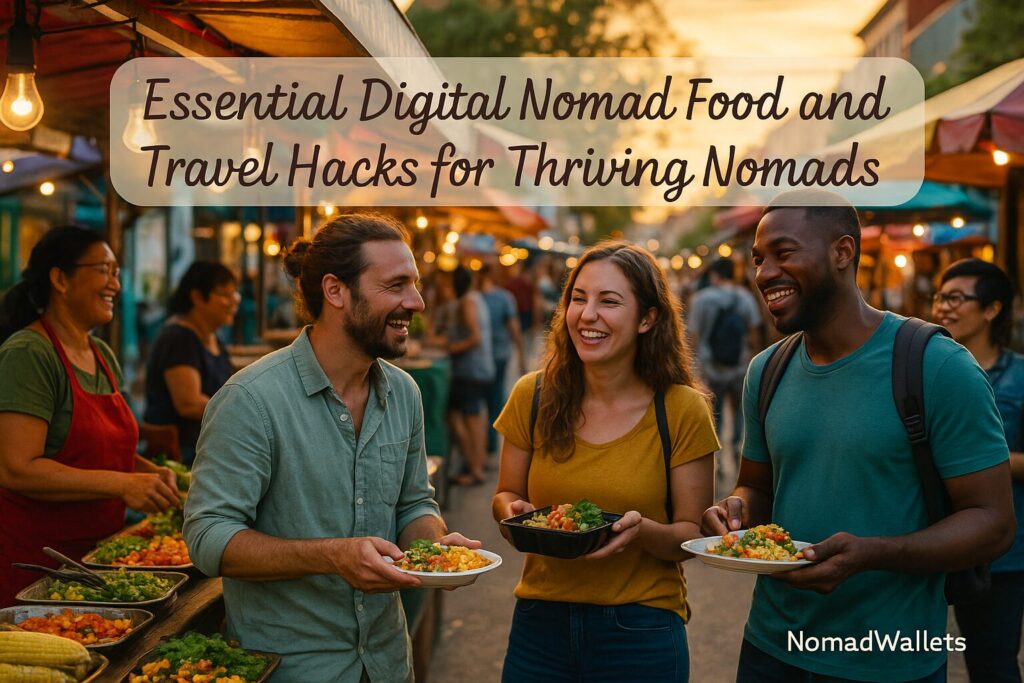
There’s a certain thrill in living the digital nomad lifestyle. One minute you’re sipping coffee in a tiny café in Vietnam, and the next you’re hunting down cheap flights to South America. But while Instagram shows the glossier side of this lifestyle, the reality is often about stretching every dollar like it’s made of gold.
Food and accommodation usually burn the biggest chunks of your budget, which is exactly why digital nomad food and travel hacks can make the difference between scraping by and living comfortably while working remotely.
This guide is a raw, down-to-earth collection of tricks learned from years of living out of backpacks, hopping borders, and making a living on Wi-Fi. If you’re a nomad on a shoestring budget, these hacks will help you save money without missing out on authentic experiences.

Why Hacks Are Essential for Digital Nomads
Being a digital nomad isn’t just about freedom and sunsets — it’s about constant decision-making. Do you take that $2 street meal or splurge on the $12 tourist lunch? Do you grab the fancy co-working space or work from a café with decent Wi-Fi? Every small choice piles up, and over months of travel, that’s the difference between thriving and running home broke.
That’s where digital nomad food and travel hacks step in. These hacks aren’t about being cheap for the sake of it; they’re about being smart so your money stretches further, letting you travel longer and explore more.
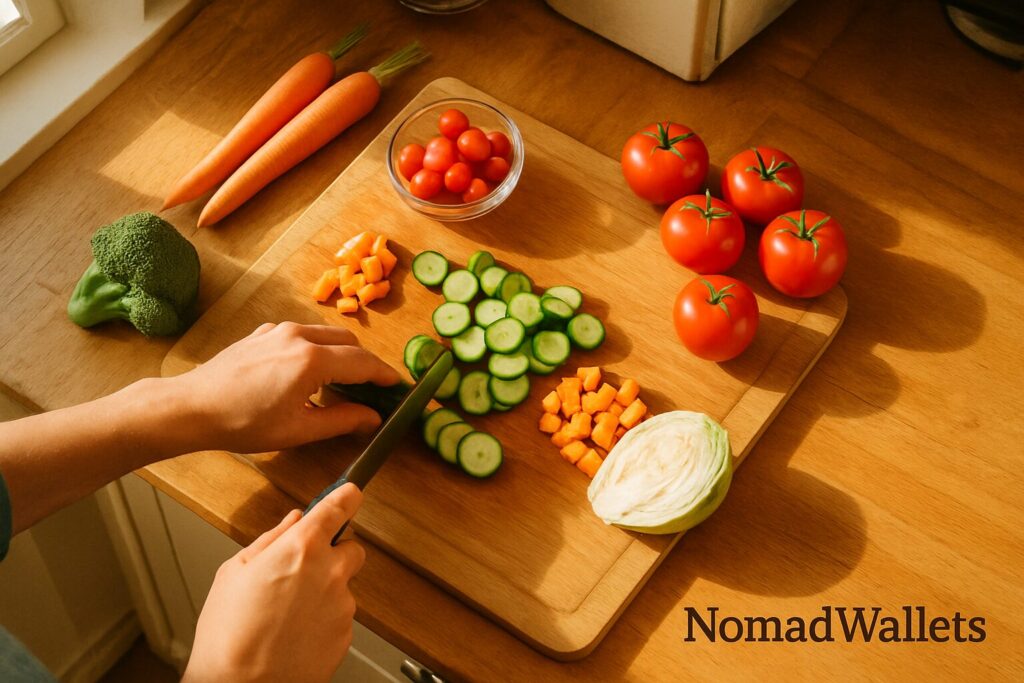
Food Hacks Every Digital Nomad Should Know
Eating on the road is tricky. You want to eat well, stay healthy, but also not drain your budget. Here are practical food hacks:
1. Street Food Over Sit-Down Meals
Street food isn’t just tastier and more local — it’s insanely cheaper. In Thailand, a plate of pad kra pao costs $1.25 from a stall while the restaurant version might run you $6. Multiply that across weeks, and you’ve saved hundreds. Plus, you get a better feel of the real culture. This is one of the most underrated digital nomad food and travel hacks, and it works almost anywhere in Asia, Latin America, or Africa.
2. Cook in Hostels or Airbnbs
Even cooking one or two meals a day saves a fortune. Think pasta, stir-fry, or local produce from markets. Pro tip: buy a small spice kit and travel with it — it makes basic meals feel gourmet while costing next to nothing.
3. Grocery Store Loyalty Cards
Supermarkets in Europe and the US give serious discounts if you have their loyalty card, and there’s no reason nomads can’t benefit. Often you can sign up with just an email address. Over weeks, you’ll notice a big difference.
4. Local Markets Over Supermarkets
Markets aren’t just cheaper; they give you fresher produce and a window into the culture. If you’re in Mexico, grab bulk tortillas at a fraction of supermarket prices. If you’re in Vietnam, haggle your way to bags of fresh fruit that’ll keep you full all week.
5. Avoid Airport Food
This is one of those digital nomad food and travel hacks you’ll thank yourself for later. Airports are designed to empty your wallet. Eat before you head to the airport, carry snacks, or pack a sandwich. Even instant noodles made with free hot water at the terminal beat paying $18 for a sad airport sandwich.
6. Use Apps to Find Meal Deals
Too Good To Go (in Europe) or local apps in Asia let you pick up leftover café meals at heavy discounts. It’s like hacking the system to eat well for less.
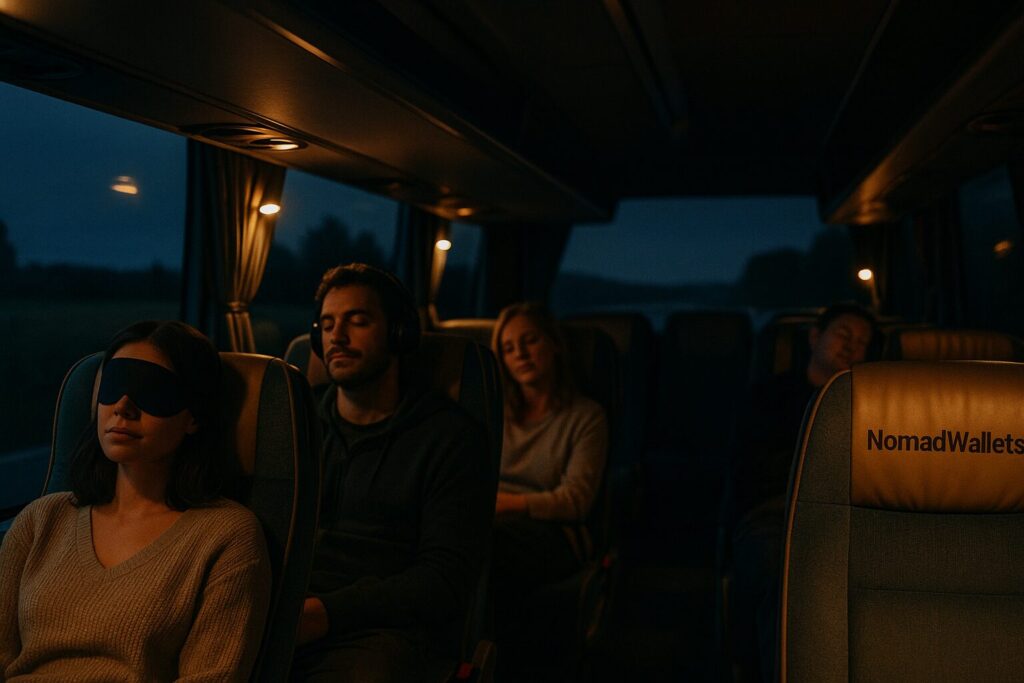
Travel Hacks That Save Big
Food is only half the story. Transport and lodging can drain your budget faster than anything. These travel hacks are lifesavers:
1. Take Overnight Buses or Trains
This kills two birds with one stone: save on accommodation and transport at the same time. Sure, it’s not luxury living — but waking up in a new city without paying for a night’s stay is a power move.
2. Use Flight Search Engines Wisely
Everyone knows about Google Flights or Skyscanner, but the good digital nomad food and travel hacks involve WHEN and HOW you search. Browse in incognito mode, consider nearby airports, and be flexible with dates — flying on a Tuesday could save you $100 compared to Sunday.
3. Housesitting & Pet Sitting
Websites like Trusted Housesitters let you stay in beautiful homes for free in exchange for watching pets. Not only does this save money, but it also gives you a cozy home base plus furry friends to hang out with.
In Europe and parts of Latin America, carpool apps like Blablacar are insanely cheap and social. You’ll spend a third of what you’d pay for a train and meet new people along the way.
5. Book Locally, Not Online
In places like Southeast Asia, booking buses or accommodation in-person often costs half of what’s listed on Western booking platforms. Local travel agents or bus counters nearly always undercut online prices.
6. Stay Longer in Fewer Places
One of the most effective digital nomad food and travel hacks is slow travel. The longer you stay in one city, the less you spend per day. Monthly Airbnbs, local gyms, and transport become vastly cheaper when you’re not hopping every 3 days. Plus, you actually get to know the place.
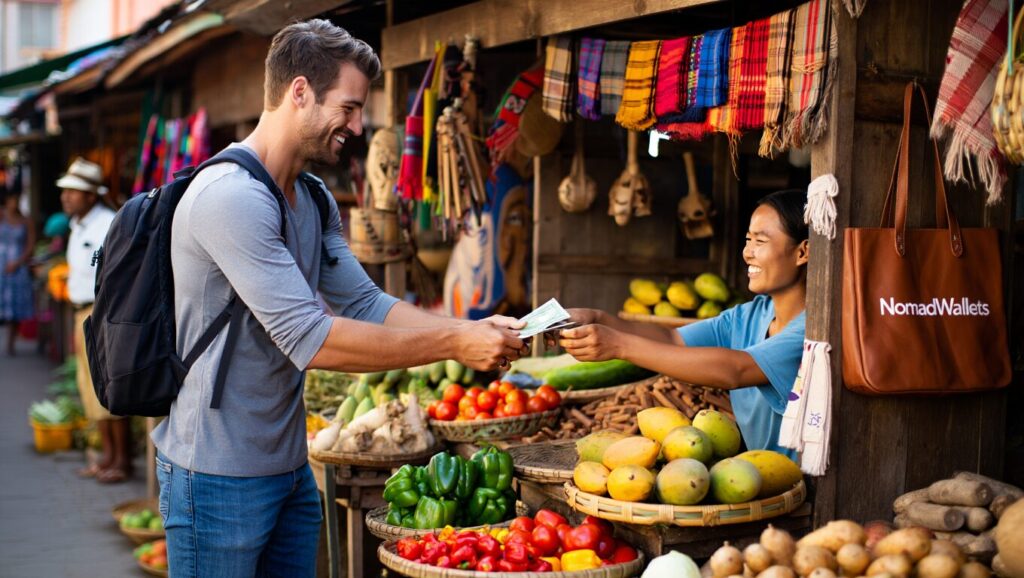
Blending Food and Travel Hacks
The smartest thing nomads can do is combine these food and travel strategies. For example:
- Take an overnight bus (saving both on lodging and transport).
- Arrive early in a new town and head straight to a local market for groceries.
- Cook two days’ worth of meals in your new Airbnb.
- Then treat yourself to street food for dinner at $2 a plate.
That combo easily slashes what most tourists would spend daily by 60% or more. And over weeks and months, this is how you stretch your shoestring budget into long-term sustainability.
Hidden Gems: Extra Hacks for Pros
If you’ve been on the road for a while, you start noticing even deeper tips — the kind of insider hacks that aren’t written on travel blogs.
- BYO Reusable Water Bottle & Filter – Constantly buying bottled water drains more money than you think. A filter bottle pays for itself fast.
- Free Walking Tours – Most cities in Europe, South America, and beyond have free walking tours. You just tip at the end, and you’ve turned hours of entertainment and history into an affordable adventure.
- Work-from-Libraries – Instead of spending $15/day on co-working, many nomads quietly work out of libraries. Quiet, free Wi-Fi, and usually air-conditioned.
- Leverage Nomad Facebook Groups & Telegram Channels – Locals and fellow travelers drop insider info daily: cheap eats, last-minute apartment rentals, rideshares. These nuggets often turn into the best digital nomad food and travel hacks.
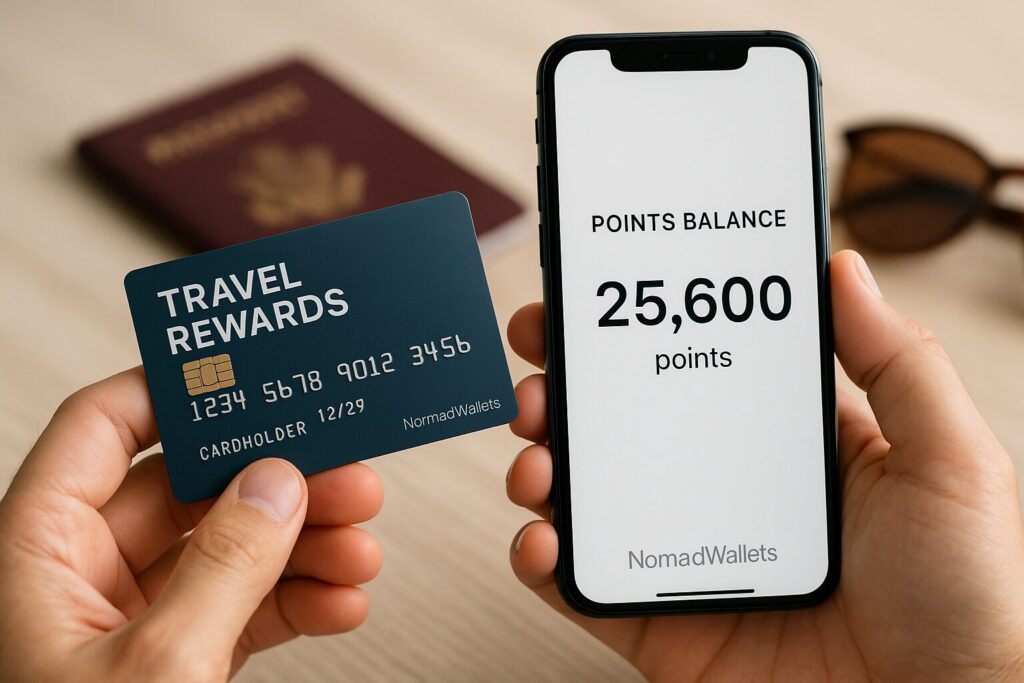
Balancing Hacks with Joy
Living frugally as a digital nomad is a balance. Hacks are not about depriving yourself — they’re about choosing when to splurge. Skipping overpriced cafés means you can afford a weekend salsa class in Colombia. Cooking four homemade meals means you can treat yourself to one unforgettable seafood lunch by the beach.
The point of using digital nomad food and travel hacks is not just to save money, but to redirect your spending towards things that bring depth to your travel life.
Common Mistakes to Avoid
Before wrapping up, here are three common pitfalls nomads make:
- Falling for “cheap” tourist deals – Many tourist-centered offers look affordable but are still overpriced compared to local options.
- Constant location-hopping – Transportation eats up more than you realize. Slow down.
- Ignoring health for savings – Cheap street food is great, but balance it with some home-cooked meals. Your health costs more than you’ll save eating $1 street burgers forever.
FAQs (Digital Nomad Food & Travel Hacks)
Q1. What are the best ways to save money on food as a digital nomad?
The top digital nomad food and travel hacks for saving on meals are: eating street food, shopping at local markets, and cooking simple meals in hostels or Airbnbs. Apps that sell discounted leftover restaurant food and supermarket loyalty cards can also make a big difference.
Q2. How do I find affordable accommodations as a nomad?
Keeping travel dates flexible and booking during shoulder seasons is a classic hack—prices drop and cities aren’t crowded. Consider Couchsurfing, housesitting, or negotiating long-stay rates. Hostels, co-living spaces, and local guesthouses often have lower rates than hotels or Western booking sites.
Q3. What is the cheapest way to travel between cities or countries?
Overnight buses and trains save on both transport and accommodation costs and are commonly used among budget digital nomads. Also, consider carpooling apps like Blablacar, and check regional budget airlines. Booking tickets in-person, especially in Asia or Latin America, often results in lower prices than online.
Q4. Is it safe to eat street food everywhere?
Generally, yes, but observe what locals are eating and go for busy food stalls with high turnover. It’s one of the top digital nomad food and travel hacks to guarantee fresh, affordable, and authentic meals without breaking the bank.
Q5. What digital nomad travel hacks help with productivity and Wi-Fi?
Working from libraries, cafés with proven Wi-Fi, and co-working spaces during free trial periods save money. Always carry a lightweight power strip, and download offline maps and work tasks for when Wi-Fi is weak.
Q6. How do I budget for a digital nomad lifestyle?
Start by tracking your biggest expenses—accommodation, food, and transport—and set daily or weekly limits. Prioritize spending based on what matters most (e.g., save on rooms to splurge on meals, or vice versa), and follow community groups for local savings and secret deals.
Q7. Are there any must-have packing hacks?
Travel light: bring only essentials to avoid extra baggage fees and the hassle of lugging a heavy bag. Packing cubes, a reusable water bottle, a universal adapter, and a basic first-aid kit are key for efficiency and budget-friendliness.
Q8. How can I save on local transportation?
Use public transit over taxis, rent bikes, or just walk whenever possible. Not only does this save money, but it’s a great way to see local life up close and discover hidden gems along the way.
Q9. What if I need community or support on the road?
Join digital nomad Facebook groups or Telegram channels for real-time tips, meetups, and support. These groups often share the latest digital nomad food and travel hacks, including local discounts, trusted service providers, and safety alerts.
Final Thoughts
Life on the road doesn’t have to mean living broke or skimping on experiences. With the right mix of strategies, you can eat well, travel far, and enjoy local life without burning through your budget.
At the core of it, these digital nomad food and travel hacks are about resourcefulness. They’re about knowing how to live smarter — finding joy in street meals, choosing overnight buses over hotels, bartering in markets, and connecting with locals in ways the average tourist never will.
If you’re looking for more inspiration, check out Digital Nomads Under $500: Top Destinations & Tips for 2025 for affordable places and insider tips to stretch your budget even further.
So the next time you pack your bag, remember: your budget isn’t a limitation. With the right hacks, it’s a tool to unlock deeper, longer, and more meaningful travels.
Hi, I’m Tushar a digital nomad and the founder of NomadWallets.com. After years of working remotely and traveling across Asia and Europe, I started NomadWallets to help U.S. nomads confidently manage money, travel, banking, crypto, and taxes. My mission is to make complex financial topics simple, so you can focus on exploring the world and building true location freedom.
